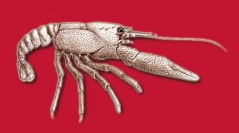

 Geodiversitas
45 (24) - Pages 689-719
Geodiversitas
45 (24) - Pages 689-719Crayfishes are well-known freshwater invertebrates with important economic, ecological and cultural significance. In East Asia, crayfishes are represented by a single family, Cambaroididae Villalobos, 1955 with a single genus, Cambaroides Faxon, 1884 which phylogenetic relations to other northern hemisphere crayfishes has been debated. Here, we review crayfishes from the Early Cretaceous Jehol biota, China, where three species of crayfishes have been described from. We observed that specimens correspond either to exuviae or body fossils, the later sometimes including preserved gastroliths. Our investigation also shows it is not possible to find any distinction between the species, leading to only one species to be recognized in the Jehol biota. Furthermore, the extinct family Cricoidoscelosidae Taylor, Schram & Shen, 1999 and its unique genus Cricoidoscelosus Taylor, Schram & Shen, 1999 are based upon characters insufficient to warrant a separate family. Perhaps the most important of these, the annulated pleopods is a plesiomorphic character of Astacoidea, with annulations most likely more visible due to fossilization. In fact, based upon the shape of the male gonopods and epistome, the general habitus, the possible presence of an annulus ventralis in females and ischial hooks in males, crayfishes from the Jehol biota can be assigned to Cambaroididae, which are currently restricted to East Asia. This suggests that members of Cambaroididae have inhabited East Asia since at least the Early Cretaceous.
China, Early Cretaceous, Konservat-Lagerstätte, Yixian Formation, Decapoda, Astacoidea, Cambaroididae, freshwater, gastroliths, exuvia, new synonym, neotypification